#m1903a4
Text
U.S. Army Airborne Snipers in WWII
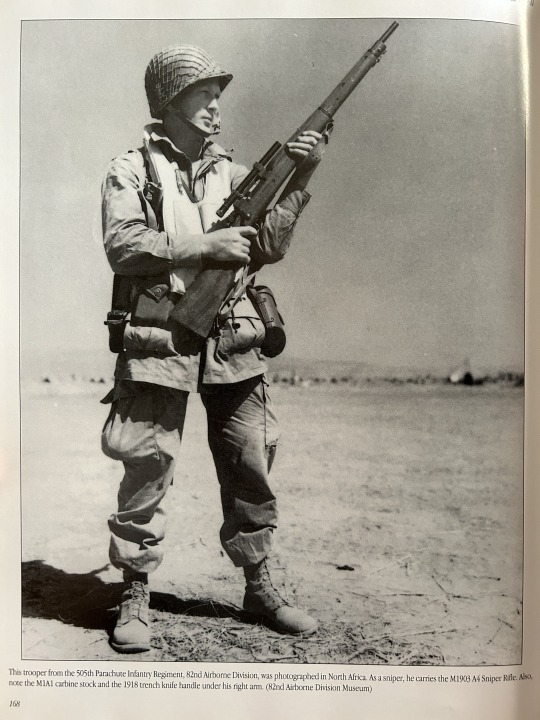
In my admittedly not especially extensive research, I have only seen one image (above) indicating that the US Airborne used M1903A4 sniper rifles in WWII, in Bill Rentz’s book Geronimo!
The above, as its caption indicates, shows a GI with the 505th Parachute Infantry Regiment of the 82nd Airborne division holding an M1903A4 in North Africa, presumably in advance of jumping into either Sicily or Salerno in 1943.
As far as I can tell the M1903A4 has a mixed reputation; few really want to come right out and say that it was terrible but people make a lot of interesting faces trying to describe its effectiveness. Some people insist it’s a legend like everything else the U.S. cranks out of its armories.
There seems to be unanimous agreement that the Weaver 330C scope, designated the M73B1 for military use, was not very good for field use as it was fragile and not waterproof.
I have one piece of anecdotal evidence that would by no means prove admissible in court but that nevertheless colors my feelings about this rifle. A friend with whom I used to re-enact had one of the Gibbs M1903A4s for a while and at one event he “took a hit” and in the process of falling to the ground holding said rifle, the reticle in the scope broke away. Granted, the earlier replica scopes they used on those were notoriously fragile even for Weaver style scopes and I am not sure whether he had the earlier or later model scope on that rifle. But I have handled other scopes of that era of comparable quality and they do not inspire tremendous confidence.
As other points of anecdotal data, I have myself felt the shock of an opening parachute and the impact of a comparatively light landing. Static-line jumping of the WWII (and modern) variety notoriously involves much harder landings; broken legs prove(d) a common injury.
So I have a hard time imagining that a 1940s scope like the Weaver 330 could handle the forces involved in jumping out of an airplane. Granted, the Enfield No. 4 Mk I (T) that the British used was issued en masse to the Airborne and survived, but the scope on that thing was built like a tank and--critically--we have plenty of evidence of that rifle’s use among the British Airborne. The M1903A4 does not appear with that kind of regularity in the records I’ve seen related to the U.S.
All that’s to say, I wonder how many jumps the above rifle survived.
But also, as this guy had the foresight to tote an M1A1 Carbine for backup, I am left with the tantalizing albeit unobtainable object of an M1903A4 with an M1A1 Carbine as an accessory
1 note
·
View note
Photo

Two combatants sit at rest. The K98k Mauser is above the Springfield M1903A4. Their army’s helmets lie next to them.
#K98k Mauser#Springfield M1903A4#sniper rifle#wwii small arms#wwii#ww2#world war ii#world war 2#second world war
129 notes
·
View notes
Photo
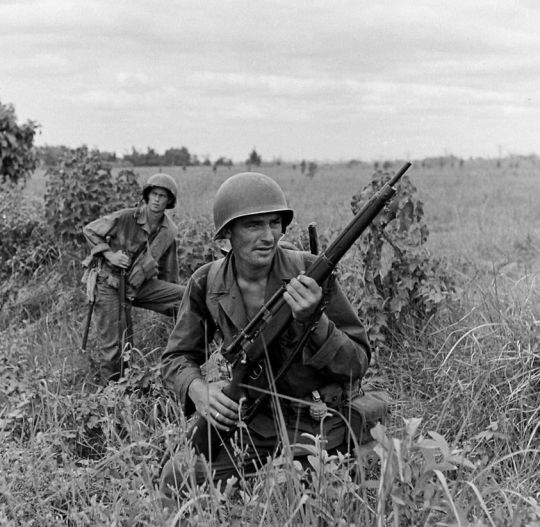
A U.S. Army Sniper with a M1903A4 Springfield sniper rifle in the Philippines near Capas, Tarlac, 1945.
12 notes
·
View notes
Text

| CHARACTER STUDY |
>> Private Daniel Jackson [Saving Private Ryan]
>> Sergeant Hazel Parker [The Soldier of Stars - Band of Brothers Fic]
A little while ago, I was talking to Linda ( @wecomrades ) and she had just read of a portion of one of my Band of Brothers fics, The Soldier of Stars, where it portrays my main OC, Hazel Parker, who is a sniper, as whispering prayers each and everytime she shoots her rifle. And so she sent me a message, saying how it was very similar to Private Dnaiel Jackson of Saving Private Ryan. And I was like, OMG THATS WHO SHE IS BASED OFF OF! And well here we are!!
When I first started drafting The Soldier of Stars, it was under a different title, had more characters instead of my 3 now, and was sorta a mess, but I cleaned it up with help from a few writer friends. But Hazel always stayed the same - derived from the character of Private Daniel Jackson of Saving Private Ryan was what I always wanted to go for!! And I did!! For a while I had been planning a sort of almost character study to show Hazel’s similarities to Jackson, but never got the time. But now since our discussion, I have been more inclined than ever to finally do one!! Private Daniel Jackson is also my favorite Saving Private Ryan character, and I just KNEW I had to go along with it!! So without further adieu, please enjoy if you wish!! It’s not much, as I don’t want to spread this out, but it’s my general thought process that I had creating the tiny lil sniper I ADORE with all my heart - Hazel Parker. 💛
INTRODUCTION + BACKGROUND
When I first created Hazel Parker as a character, I wanted to create a quiet, introverted character that people of the more introverted side of the fandom could relate to - who was also a strong female character in her own ways, and also a pretty badass sniper :) So I drew inspiration from Private Daniel Jackson of Saving Private Ryan, pretty heavily - similar ways of seemingly approaching the war, firing their weapon and saying prayers to accompany it, being religious, sort of an quieter personality (they can do their job and do it well). I drew multiple different things from Private Daniel Jackson to add to Hazel Parker as a person and the outcome was exactly what I had hoped to get!
(1) This Is Just Pure Irony
When Hazel Parker was simply just an idea, with no name, no face claim, nothing really, I just spent time watching war films, gathering ideas, personalities, all of that. The name came to me one night a few minutes before I fell asleep and I really just loved the name ‘Hazel Parker’ together, because I felt it was fairly unique, yet it worked for many, many reasons. And then I went and rewatched Saving Private Ryan and found something out that I LOVED and still LOVE to this day.
The man who was up with Private Daniel Jackson in the bell tower was named Private Parker. And I honestly just love the irony and connection between that, because then I went and created my own Private [Hazel] Parker. I just loved it because Hazel is based off Private Jackson and then there was that connection and I just loved it! :)
(2) Religion
Private Daniel Jackson is described as a ‘devout Christian’ and he wears a cross as well as whispers prayers directly from the [King James Version] Bible before shooting his Springfield in combat, which is something paralleled with what I made Hazel do as well as a Christian.
As a child, Hazel had nowhere to look after her father left and Faith and God were really the only things she could follow after and look to, to guide her she felt because there was nowhere else to go and she felt so lost. This follows her into the war year with Easy Company and eventually into postwar.
But I used her description of being Christian to show the morals she held in war almost constantly and how she viewed the war and how God was with war.
One of the most pivotal scenes to describe this moment is between Hazel Parker and Shifty Powers in Bastogne (two who grow to become close friends), where Hazel is talking about how ‘God tells her to love her enemies’, but how can she do that when the enemy does cruel things such as this war? She has a power struggle with her Faith in God and in the reality of war and I present this struggle in many different situations - yet she still remains faithful in the end, which I love. God was there for her through her childhood and through war and she respects that.
(3) Prayer Whispers
Just like what I mentioned above, a bit, actually is the fact that like Jackson, Hazel is a Christian and similarly whispers prayers before each shot she takes in battle. For how morally coded she is, she is not a fan of death but knows she can not avoid it and whispering a prayer for the life she takes it better than saying nothing in her stance, wishing them well in the afterlife and hope God protects her afterwards for what she has done and committed.
Private Jackson - Psalm 25:2
“ O my God, I trust in thee: let me not be ashamed, let not mine enemies triumph over me.”
Corporal Hazel Parker - Not Specified
“ By God, rule me and guide me, ever this day, be at my side, to light and to guard.”
The examples above are just two excerpts of what both tend to say throughout the course of the book and movie and I think this was the major connection that many people made throughout the course of The Soldier of Stars was how Hazel reminded them of Private Jackson. And I felt super happy that in the end, that was what I had initially hoped for when I had started. It was a nice feeling to have.
(4) Motives
For me, I felt their motives were also very similar - that is Private Jackson and Corporal Parker.
In my own interpretation from when I saw Saving Private Ryan, Private Jackson just seemed like the sort of guy, who was there for his friends, highly caring, highly intelligent and skilled, he knew his place, and he had this sort of persona about him that said ‘I’ll go where ever the war takes me, as long as this rifle is in my hand.’ and Hazel is VERY similar to that in many senses.
Hazel Parker, who doesn’t exactly know her place in the beginning of the fic eventually does find her place, and then remains reliable, intelligent, skilled and focused in her position as she does so - along with the idea of ‘Wherever I go in war, I want my rifle in my hand.”
( Might I mention that both shoot with Springfield rifles ;) )
Even though Private Jackson has much more confidence than Hazel does, his confidence is just an outward confidence of her inward confidence. He speaks it, saying he could kill H*tler from a mile away. Now, Hazel would never say that, but she sure could easily think that. She knows by the middle of the book really she’s good and doesn’t need to say it, she just needs to have that confidence in herself - but it is a very similar sort of confidence overall.
(5) Just some Fun Facts!
It is said that Private Jackson was born in West Fork, Tennessee and I, coincidentally made Hazel Parker also born in Tennessee in Pigeon Forge! They have a bit of the Southern Charm.
Like I mentioned above - they both shoot with the exact same sort of Sniper Rifle - the M1903A4 Springfield Rifle and are highly outstanding marksman that both Captain Miller and Major Winters put faith in for the two of them in their separate ways.
They tend to be able to do solo missions, sometimes with or without a spotter. The M1903A4 Springfield Sniper rifle was used by the US Army during World War 2 and feds a 5 round magazine and is bolt action. And one of the things I liked about this rifle is you didn’t always quite need a spotter for it to be in use - most snipers have a spotter with them for calculations and such - but with this rifle, it is not always required, for if you need to drop and shoot, it still is effective.
Private Jackson does this many times, such as in the very beginning on D-Day on Omaha Beach as well as a bit later on when he faces off with a German Sniper in a downpour in Neuville. And then he continues again in the Bell Tower where he meets his death.
I portray Hazel as doing a very similar thing when she attacks with Easy Company in Brecourt Manor and is positioned up in a tree, before moving to the first gun - a spotter is not required for her to be effective. She does it again in various moments through out the Normandy Campaign such as during the Battle of Carentan, where she kills from above and in the Battle of Bloody Gulch. We see her again in action in Nuenen and throughout Market Garden and into The Island again where WInters has faith to send her up along the dike away from everyone else to battle.
The last time we see her in this position is in Bastogne in various, different situations where she is effective and makes it work - one of my ALL TIME FAVORITES actually. It is her night time solo mission to recover the body of Private John Julian, which she does with success and it is I feel one of the most pivotal moments for a character like her because by then we know she can fully handle herself in many, many ways. We see a bit of her inner battle there as well which I love because her mind is highly complex, congested and always in a mind-battle, but I love it and we really get to see her inner thought for what they are.
And, I also sorta based it on Physical Appearance - neither are exactly the biggest soldiers there - as that is where Hazel got ‘Tiny’ for a nickname really, but being tiny as a sniper works for Hazel because she can move around quickly and hide away easily as well, so her build was based similarly off of Private Jackson’s.
OH fun fact - it seemed to be that when it came to Jackson’s friends, he was not afraid to quite literally kill for them, Hazel was very much made the same way.
Something that goes off of this is Hazel’s repetition of the ‘bright green-eyed, German soldier’ she killed on her first day in the early hours of the morning. He haunted her in different ways throughout the war (she had killed him with a knife which she had the entire war) and by the end we see her confront the man who shot Chuck and put the knife that killed that German, to the man’s throat. By the end she throws down the knife as a signal that she won’t let the German with the bright green eyes follow her anymore, which gave me, personally, strong Jackson vibes in a way which I loved to write :)
HEY! so this was sort of my view I took on making Hazel Parker similar to Daniel Jackson in many aspects, just taking important bits and chunks that I noticed and incorporating it like that! I really enjoyed making this and Daniel Jackson had always been a huge inspiration so I was excited to make a character similar to him!! I do this with most of my OC’s in various degrees actually, but this one was on my mind for a while so I was excited to finally do it!! Huge thank you to Linda for being so interested in this topic and hyping me up for it!! I hope you enjoyed, my friend! <3
#band of brothers#saving private ryan#bob fic#the soldier of stars#hazel parker#daniel jackson#corporal parker#private jackson#character study
16 notes
·
View notes
Photo

US Army Pfc. Edward J. Foley of the 143rd Infantry Regiment of the 36th Division cleaning his Springfield M1903A4 sniper rifle, near Valletri, Italy, 29 May 1944. https://wrhstol.com/2XV3Pfk
54 notes
·
View notes
Photo

OSS Detachment 101 in Burma, ca 1943-1945. OSS member is likely holding a modified M1903A4 Sniper Rifle with the wooden hand grips removed after the sling swivel retaining band.(NA) #5
32 notes
·
View notes
Photo
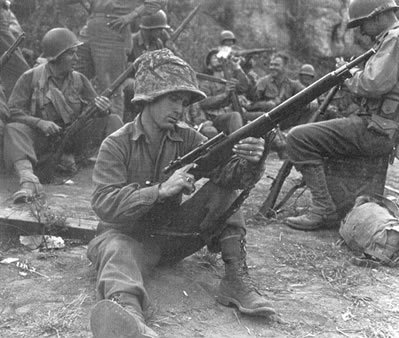
US Army Pfc. Edward J. Foley of the 143rd Infantry Regiment of the 36th Division cleaning his Springfield M1903A4 sniper rifle, near Valletri, Italy, 29 May 1944
US National Archives
41 notes
·
View notes
Photo

PFC Edward J. Foley of the 143d Infantry, 36th Infantry Division, clears his Springfield M1903A4 with Weaver M330C near Velletri, Italy. May 29th 1944. [Colorized] [1896x1506] Check this blog!
8 notes
·
View notes
Note
‘ i’m not leaving you behind. ’
Seriously. Seriously.
What was it with these die hard bleeding hearts and their damn determination to make sure he never got left behind? Steve was bad enough - and never mind that he wouldn't have left anyone behind either - but Mollie was a nice Brooklyn girl and a damn good nurse and had been with the field hospital the Commandos had just liberated from the edge of HYDRA's front line. Bucky growled a little as he tied off a rough bandage over his left arm to stop some bleeding, and shouldered his M1903A4 over his shoulder.
"You're not leaving me behind," he told her seriously as he caught her arm in a firm, but gentle grasp. "I'm sending you back to clear the way, okay? We'll need a camp set up on the Allied side of things when we get back, and I can't think of a better nurse to run the operation. I'll be fine, I've been in worse scraps than this back home."
At that, Bucky flashed her a million watt grin, and released her from his grasp. The grin didn't quite go to his eyes - no delight really went to his eyes ever since his rescue from Azzano in '43 - but he was making a damn good effort regardless.
"Get on now. Cap's counting on you all. We all are. Unless you're gonna grab a gun and wade right into HYDRA's forces with us."
0 notes
Text
A lot of my collecting of WWII stuff was inspired by Medal of Honor: Frontline. I was playing it one day the summer I had my first job and I wondered while playing how hard it would be to find a helmet from WWII.
After acquiring said helmet, I set about putting together the uniform of this little knockoff G.I. Joe I had bought when I was a freshman in High School, dubbed "pocket Jimmy Patterson"

Pocket Jimmy Patterson there is a Sergeant in the 101st and was sold as a D-Day soldier but he's actually dressed for Market Garden.
I landed on paratroopers in part because of pocket Jimmy Patterson, and in part because I like airplanes. From there, I went with the 101st over the 82nd because I already thought they had the best patch, I liked the playing card insignia painted on the side of the helmet, the number 101 is aesthetically pleasing, and I didn't know about any other airborne units.
I mean,
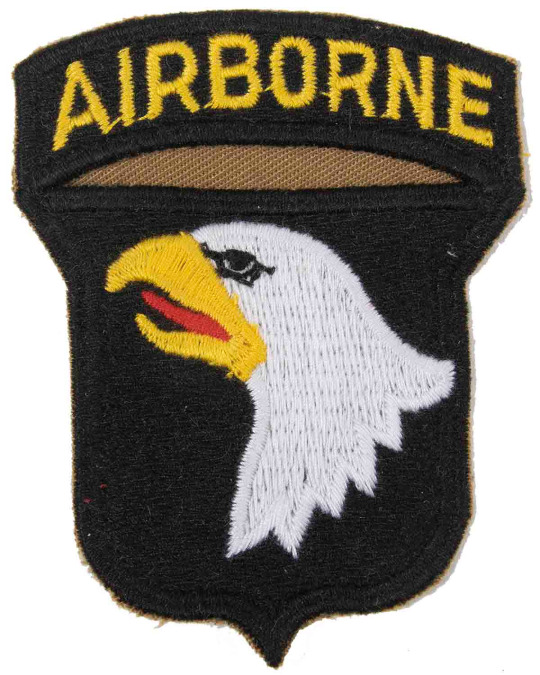

Come on.
(the 101st is the one on the left, and the 82nd on the right, if you didn't already know)
I say all that because if you know anything about WWII collecting and especially re-enacting you know that elite units are dramatically over-represented and for the U.S. nobody more than the 101st, and this can be blamed almost exclusively on Band of Brothers, a show I had not even seen when I landed on the 101st.
How bad is it?
Well, by way of illustration, as a stress response to the final stages of my dissertation I've been retreating into buying WWII paratrooper stuff again, and I was questioning whether I hadn't better go with another unit this time. I had a great great uncle killed in the Philippines in WWII who was in the 11th Airborne so that's an obvious candidate, but of course if you want to stick to Europe and fighting Nazis your options are the 82nd, 101st, or 17th. Of those, the 17th only really got into the war in 1945 and if you want to do Normandy, as some 90% of re-enactments do, then you're between the 82nd and the 101st.
The 82nd has a much longer history than the 101st and, objectively, and I mean this with all implied asterisks and am speaking as though I were a twelve year old who does not know better, the 82nd is cooler, the inferior number/patch notwithstanding.
So I was on a website that is well-regarded for selling WWII militaria and they have a section for patches and I was doing some comparison of original WWII-era divisional patches. The cheapest 101st Airborne patch from WWII this guy has for sale is $175, most of them hovering closer to $300, and some in the $600 range.
11th, 17th, and 82nd patches are in the $50 range.
When I still did re-enacting as the 101st, I remember talking to some of the guys who were disappointed with the rather low "authenticity" standards of our unit (always something of a joke when a considerable number of G.I. re-enactors are in their 40s-60s and dramatically overweight), especially considering that the 101st Airborne are one of the most cartoonishly over-documented units in WWII, for whom reproductions of everything are widely available, and so there's really no excuse not to have your uniform and equipment more or less 100% correct.
Sure enough, trying to do a little research into the 82nd to see what that pool would be like, the resources are shockingly slim. The 101st had two combat jumps in WWII, Normandy and Holland. The 82nd jumped into Sicily, Salerno, Normandy, southern France, and Holland. They have a much longer combat record and are, comparatively speaking, almost totally neglected by idiots like me who are into WWII.
Even as I say all this
I am having a hard time severing the internal connection to 101
#wwii#ww2#re-enacting#my militaria#you know#I never actually pieced together the full Pocket Jimmy Patterson uniform#I never got that M8 scabbard#never got the wire cutters#never got a Thompson#and I never got that shoulder bag#the rest of the stuff I did acquire#at this moment the only stuff on him that I have is the 1911 the helmet the scarf the belt the flag brassard the 1911 mag pouch and#ironically perhaps#that M8 scabbard#I think if I focused on the 82nd I'd try to do the 505th because there's a picture of a guy from the 505th with an M1903A4 before Italy#also they had a rampant lion (panther?) painted on the side of the helmet for Italy#not for Normandy I don't think#the 509 are also cool but they're an independent regiment
17 notes
·
View notes
Photo
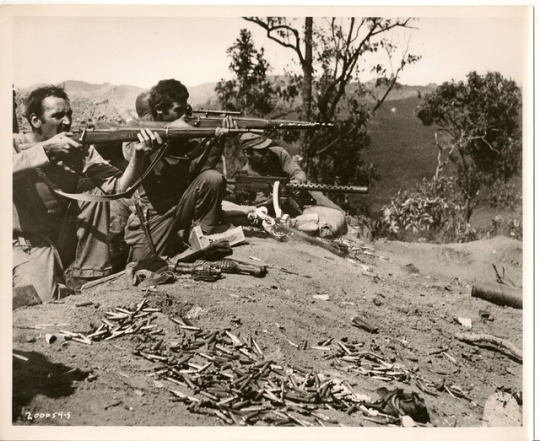
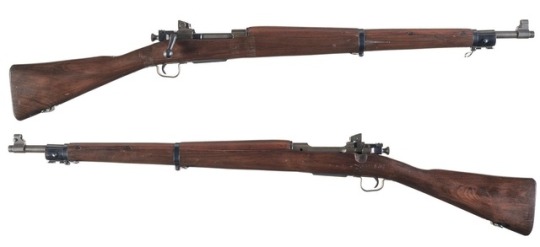



The Simplified Springfield: M1903A3
In May 1942 the US Ordnance Department authorised the designation of a new version of the Springfield M1903 - the A3. While the M1 Garand had been in production for several years and M1903 production at Springfield Armory had ended in 1938. It resumed in 1942, with a modified pattern at Remington before a further simplified variant was introduced as the M1903A3.
The M1903A3 made a number of significant changes to simplify, expedite and reduce the cost of production. Bruce Canfield suggests that as many as 649 changes were made to the M1903, with many being made during the A3′s production run. The most significant changes included the switch to a receiver bridge-mounted rear aperture sight which replaced the earlier 1905 rear tangent sight. This allowed for the simplification of the handguard along with the elimination of the characteristic finger groove cut in the stock. Some parts included the trigger guard were stamped and less machining was done on other parts including the bolt and cocking piece.

M1903 (source)
The front sight was also changed as was the barrel contour beneath the handguard. The M1903A3 was produced with all three types of stock including the scant-grip, C and S stocks - the latter being the most common.
The first batch of 1,909 M1903A3 rifles were delivered in December 1942. Remington and Smith Corona, a typewriter manufacturer, were contracted to produce the simplified Springfields. Over a million rifles were ordered before production was cancelled in February 1944. Remington is believed to have produced 783,844 M1903A3s, while Smith Corona built a further 236,831.
Both two and four groove rifling was used in the Remington-made rifles and the M1903A3 was no less accurate than the earlier Springfields, with around 1,000 later being used as National Match rifles. The A3 also provided the base for the M1903A4 sniper variant. The Army, Navy and Marine Corps received A3s as did the American-equipped Brazilian Expeditionary Force (see image #6). The M1903A3 remained in Navy and National Guard service for many years after the Second World War. Both during and after the war M1903A3s were provided to America��s allies as military aid. When the Republic of Vietnam gained independence from the French in 1955, some M1903A3s were given to the new republic’s army. These likely saw action during the early stages of the Vietnam War.
Sources:
Images: 1 2 3 4 5 6
The Model 1903 Springfield Rifle and its Variations, J. Poyer, (2008)
The M1903 Sprignfield Rifle, L. Thompson, (2013)
If you enjoy the content please consider supporting Historical Firearms through Patreon!
#History#Military History#Firearms History#M1903#WWII#World War Two#Springfield M1903#Remington#Smith Corona#Rifle#Bolt Action rifle#Second World War#Firearms#Weapons#gunblr
109 notes
·
View notes
Photo
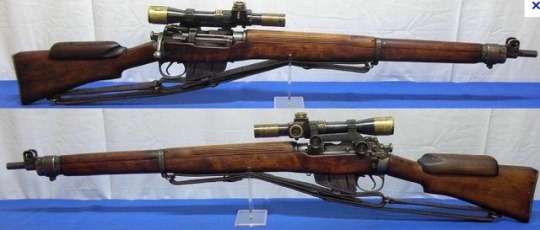



I'm sorry but may we all take a moment to appreciate the aesthetic of old military marksmen rifles? In order: No.4 mk1 (T) M39 SOV M1903a4 M41 So nice
31 notes
·
View notes
Text
Memorial Day Salute: The Venerable Springfield 1903
If you are looking for your own piece of history, this circa 1918 Springfield Model 1903 is in our vault currently and is looking for a forever home.
In honoring those who have sacrificed while serving in the United States Armed Forces, we look at perhaps the longest-serving firearm in the U.S. military, the M1903 rifle.
First prototyped in 1900, the Mauser-style bolt-action Springfield service rifle was intended to replace the only recently adopted .30-40 caliber Krag-Jørgensen series of rifles which were found to have been less than stellar in service when fighting the Spanish in Cuba in 1898.
Type classified and adopted in 1903, the guns initially had a series of teething problems in their early life — including the personal intervention by President Theodore Roosevelt into the design of the rifle’s bayonet — but were soon equipping both the Army and Navy.
Noted for its accuracy, the M1903 was soon the standard rifle at the National Matches and is still seen at Camp Perry today. Here, Ohio National Guard Col. Charles B. Winder, a well-known marksman who in the 1908 Olympics won a gold medal in the team military rifle event, fires a Springfield. (Photo: Library of Congress)
There had been over 800,000 M1903s produced by the time the U.S. entered World War I in 1917.
The “ought-three” saw some of its first combat service with the Navy and Marines ashore in Haiti, Central America, and Mexico as early as 1914. These armed sailors, from the battleship New Jersey in 1915, have the newly issued rifle. (U.S. Navy Photo)
Serving “Over There” in France during the Great War in 1917-18, the M1903 was augmented in service by the Remington, Winchester, and Eddystone Arsenal-produced M1917 Enfield, also chambered in .30-06. However, the Springfield was still considered the primary rifle of the U.S. Army until the semi-automatic M1 Garand was adopted in 1937.
When the U.S. entered World War II in 1941, although the M1 was officially “king” in the Army, the Marines still used the M1903 throughout the early campaigns in the Pacific including the defense of Wake Island and Guadalcanal.
This M1903, currently in the collection of the U.S. Marine Corps Museum, was used by Marines defending the outnumbered outpost at Wake Island. The Japanese captured it when they took the island in December 1941 and reissued it. The Marine unit accepting the Japanese surrender at the end of the war recovered the weapon. (Photo: USMC Museum)
Further, a modified version of the rifle, the M1903A3, was produced by Remington Arms and Smith-Corona during WWII for issue to support units and as military aid to allies. In all, more than 3 million 1903s came off the assembly lines by 1945, ending the rifle’s 42-year production run. Specially equipped M1903A4 versions, complete with Weaver optics, were issued to snipers and remained in limited service until as late as the 1960s.
The M1903 was at D-Day, as witnessed by the gear carried by these U.S. Army troops in the Signal Corps photo from June 6, 1944. An M1903 is to the far left and stands out in the landing craft full of M1 Carbines. (Photo: U.S. National Archives)
Although the M14 had replaced the M1 Garand and was itself phased out in favor of the M16 in the 1960s, thousands of M1903 Springfields continued to serve in the armories of Navy and Coast Guard ships as well as for drill purposes throughout the military during the Vietnam and Cold War-eras.
Today, the M1903, out of production for more than 70 years, still pops up in the hands of those on color guard details, in base historical display museums to allow those serving today to better understand what past Soldiers and Marines carried into battle, and on Coast Guard vessels converted for use as line throwing guns.
The M1903 continues to soldier on with the military in a variety of uses (Photos: U.S. Department of Defense)
On a recent tour of the Civilian Marksmanship Program warehouse in Anniston, Alabama, the non-profit had just received several M1903 drill rifles from the Army, seen here sandwiched between M1s in their shop racks. (Photo: Chris Eger/Guns.com)
Odds are, the last American serviceman to hold an M1903 hasn’t been born yet.
Check the great selection of M1903 rifles and more inside the Guns.com collection and Certified Used Guns.
The post Memorial Day Salute: The Venerable Springfield 1903 appeared first on Guns.com.
from Guns.com http://bit.ly/2wnSIfX
from Blogger http://bit.ly/2YFHG1Q
0 notes

